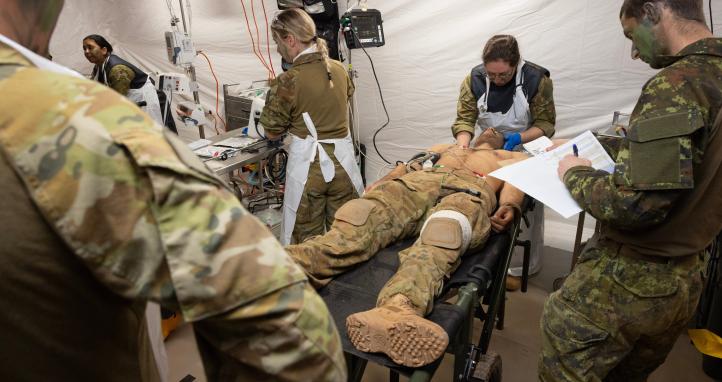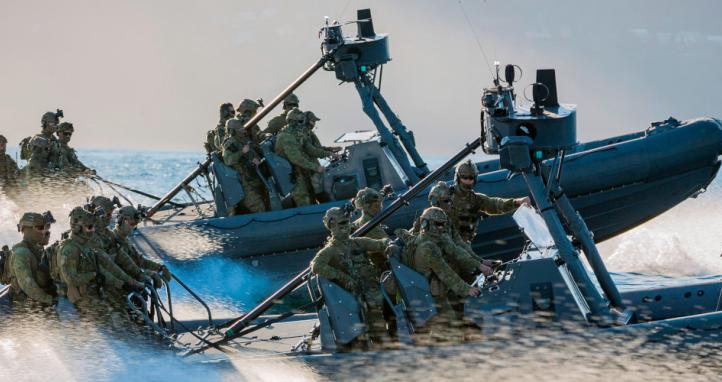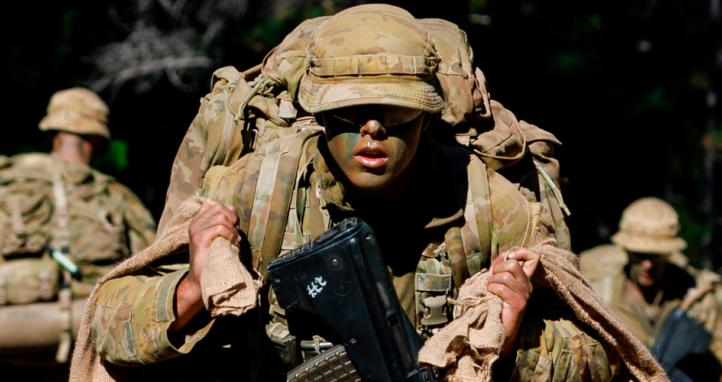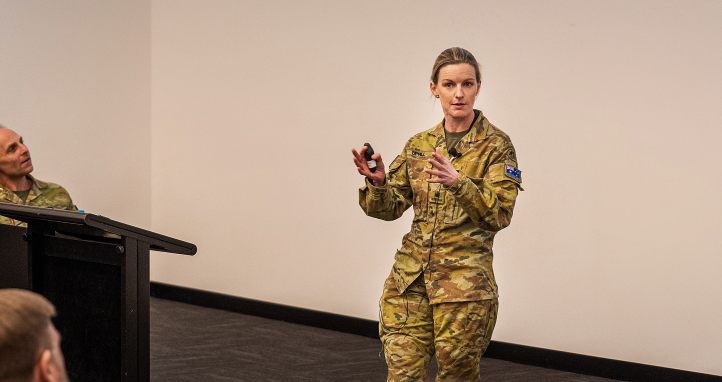Introduction
Service within the military requires soldiers to develop and maintain high levels of physical and mental robustness and preparedness to operate effectively within extremely austere, hostile and rapidly changing environments. As part of this preparation and training, soldiers are expected to carry heavy external loads for extended durations across varying time domains. This training requires soldiers to operate at times with minimal sleep and inadequate nutrition; leading to maladaptive states, increased rates of neuromuscular fatigue and subsequent musculoskeletal injuries (Macartney et al. 2021; Merrigan et al. 2020; Merrigan, Stone, Martin et al. 2021; Vaara et al. 2021).
To ensure soldiers are physically prepared for these environments, the physiological qualities of muscular strength and power need to be regularly trained utilising periodised strength and conditioning and assessed through relevant testing batteries. This ensures soldiers can withstand and resist the rigours of military occupational tasks, associated load carriage, and accumulated neuromuscular fatigue, whilst minimising the risks of overtraining and subsequent musculoskeletal injuries (Carlson & Jaenen 2012; Merrigan et al. 2020; Nindl et al. 2015; Vaara et al. 2021).
Whilst strength and power in athletic populations has been strongly correlated to jumping, change of direction, and sprinting performance (Comfort et al. 2018; Lum, Haff & Barbosa 2020), research has also shown maximal strength to be strongly correlated to performance in various military occupational tasks such as load carriage, manual handling, climbing/scaling obstacles, and casualty drags (Carlson & Jaenen 2012; Merrigan, Stone, Martin et al. 2021; Nindl et al. 2015; Vaara et al. 2021).
Although the assessment of maximal strength and power through one repetition maximum (1RM) testing has shown strong reliability, this assessment method requires lengthy skill development and familiarisation (Merrigan, Stone, Hornsby et al. 2021). It has also proven to increase neuromuscular fatigue whilst being unable to determine other important force-time metrics such as impulse, rate of force development (RFD) and force at various time epochs (Comfort et al. 2018; Comfort et al. 2019; Guppy et al. 2018a). With reliable force plate testing and analysis now becoming extensively used in military populations, practitioners are better able to assess these metrics to understand the potential decrements in neuromuscular function, due to testing simplicity, time efficiency and reduction in injury risk and fatiguability (Comfort et al. 2018; Dos’ Santos et al. 2017; Dos’ Santos et al. 2018).
Two of the most utilised neuromuscular assessments using force plate technology are the countermovement jump (CMJ) and isometric mid-thigh pull (IMTP). Each test provides a different assessment of lower limb explosive power and maximal strength, being dynamic and isometric, respectively. Due to military physical training being synonymous with large cohorts of soldiers and constant time pressures; the requirement for safe, efficient, and reliable baseline and periodic assessments to monitor neuromuscular performance and fatigue are extremely important.
Dynamic & isometric strength testing
Along with the IMTP, the CMJ and squat jump can be used to determine what is known as the Dynamic Strength Index or DSI. The DSI is a ratio comparing the ballistic peak force recorded during either the CMJ or squat jump and isometric peak force recorded in the IMTP (Comfort et al. 2018; Suchomel et al. 2020).
The DSI is used by strength coaches and practitioners to better individualise and prescribe strength-based training based on the following metrics. A low DSI score (<0.60) refers to the requirement for a greater emphasis on ballistic strength training; a moderate DSI score (0.60-0.80) refers to a concurrent strength training recommendation; and a high DSI score (>0.80) refers to a maximal strength training recommendation (Comfort et al. 2018; Suchomel et al. 2020).
Countermovement jump
The countermovement jump (CMJ) has been well researched as one of the most valid and reliable multi-joint dynamic strength tests used by practitioners to assess lower limb neuromuscular performance (Comfort et al. 2018; Sole et al. 2017), as well as monitor neuromuscular fatigue (Gathercole et al. 2015). The reliability of various CMJ force-time metrics has been reported, including jump height, peak force, peak power, peak velocity, and velocity at take-off (Claudino et al. 2016; Heishman et al. 2020; Souza et al. 2020). In the meta-analysis by Claudino et al. (2016) the authors highlighted that the average of multiple jump heights rather than the highest jump height alone, was found to be more reliable and sensitive in detecting fatigue state, although this meta-analysis excluded CMJ studies using arm swing.
From a methodological perspective, various research has conducted CMJ with or without arm swing, with some studies including hands secured to a weightless bar resting on the shoulders, due to the use of linear positional transducers attached to the bar and the lack of force plates. In 2020, Heishman et al. conducted a randomised cross-over study of college basketball players and concluded that CMJ with arm swing may be more reliable in detecting changes in sports skill performance, whereas CMJ without arm swing should be used in the monitoring of athlete fatigue and readiness. This study reinforces the point that the CMJ, irrespective of the use of arm swing or not, is a complex, dynamic task that requires a degree of skill to attain best performance.
Now with the extensive use of force plate technology, it has become extremely important for practitioners to analyse and understand the phases of the CMJ to gain insight into the temporal and kinetic characteristics within force-time curves that define movement (McMahon et al. 2018; Sole et al. 2017).
Isometric Mid-Thigh Pull
Since the IMTP was first researched in the late nineties by Haff et al. (1997), it has become the gold standard regarding the valid and reliable assessment of maximal isometric multi-joint force production. IMTP has shown strong correlation across numerous athletic strength and power tasks such as; 1RM squat, power-clean, snatch, deadlift and bench press (Beckham 2015; Comfort et al. 2019; Dos’ Santos et al. 2017; Guppy et al. 2018a), throwing, sprinting, jumping and change of direction tasks (Comfort et al. 2019; Guppy et al. 2018a), and sports such as sprint cycling, wrestling, track and field, soccer, and American Football (Comfort et al. 2019; Guppy et al. 2018a; McGuigan et al. 2010).
Although research has shown maximal strength to be strongly correlated to performance in various military occupational tasks such as load carriage, manual handling, climbing and scaling obstacles, and casualty drags (Carlson & Jaenen 2012; Merrigan, Stone, Martin et al. 2021; Nindl et al. 2015; Vaara et al. 2021). Limited research exists regarding IMTP within and between session reliability and correlation in military cohorts and associated tasks.
Methodological considerations of the isometric mid-thigh pull
To ensure reliability through repeated testing, the IMTP has several methodological considerations regarding testing setup that need to be considered by practitioners. The first of these considerations is the participant’s bar height position. Although the test name suggests, bar height would sit at the participant’s mid-thigh position; over the years several research studies have reported conflicting opinions. Early research by Haff et al. (1997) and supported by Comfort et al. (2019) and Guppy et al. (2018b), describes bar height that should be analogous with the initiation of the second pull of the clean (barbell across upper thigh, inferior to the hips), ; however, McGuigan and Winchester (2008) also discuss the use of the mid-thigh position measured between the centre of the patella and iliac crest.
Authors further elaborate with conflicting findings around the use of joint angles at the knee and hip. Comfort et al. (2019) explains optimal angles of 125-145° at the knee and 140-150° at the hip, whereas Guppy et al. (2018b) discuss approximate angles of 130-145° and 140-145° at the knee and hip, respectively. Research by Beckham (2015) however, compared two different pulling positions; being an upright position (125° knee / 145° hip angle) and a bent position (125° knee / 125° hip angle), and found that an upright position allowed for faster attainment of peak force due to biomechanical efficiency. In a test-retest reliability study by Comfort et al. (2015), the authors highlight that knee or hip angles have no kinetic effect on variables. Therefore, given bar height is standardised for individuals across testing sessions, participants should be allowed to self-select their preferred posture.
The second consideration is body position. Although there is conjecture in the literature as detailed previously around bar height which impacts body position, the consensus amongst authors is that: feet should be hip width apart centred on the force plates; knees flexed under the bar; shoulders depressed and retracted, sitting over or slightly behind the bar; maintaining an upright torso (Comfort et al. 2019; Dos’ Santos et al. 2018; Guppy et al. 2018b).
The final consideration for IMTP is focussed on grip strength. Comfort et al. (2019) and Elkins (2020) recommend that to negate the effect of grip strength failure and maintain testing reliability, the use of lifting straps should be used, as highlighted by Haff et al. (cited in Dos’ Santos et al. 2018).
Practical atandardisation protocols
To increase the reliability of assessing large military cohorts, several standardisation protocols should be implemented to ensure consistency throughout baseline and periodic testing. As per all military lessons, personnel should be given a full demonstration and explanation of both CMJ and IMTP assessments, including detail of acceptable and non-acceptable force traces. Infographics for each assessment, including those acceptable and non-acceptable force traces should be displayed throughout the testing area and personnel should be provided real-time visual biofeedback through large monitors, of their individual force traces and asymmetry graphs to enhance the learning effect.
Prior to testing all personnel should be taken through a standardised dynamic warm-up using a modified Raise, Activate, Mobilise and Potentiate (RAMP) protocol (Jeffreys 2007), which should be used for all subsequent testing. CMJ should be conducted preceding IMTP to reduce the potential effect of post-activation potentiation (Beato, Stiff & Coratella 2021; Sirieiro et al. 2021), and all CMJ should be conducted with the hands on the hips according to previous research (Claudino et al. 2016; Heishman et al. 2020). IMTP bar height should be measured for all personnel according to previous research (Comfort et al. 2015) and recorded for reliability purposes, with body position and the use of lifting straps standardised across testing sessions.
All personnel should be coached, cued, and verbally encouraged throughout both assessments, particularly the IMTP to ensure maximal neuromuscular performance is achieved in important force-time metrics such as rate of force development, peak force and impulse (area under the force-time curve). All non-acceptable force traces should be removed from the analysis software to prevent data skewing. Testing should be conducted at the same time of day to ensure consistency and reliability of data across subsequent testing batteries.
Conclusion
Reliable force plate testing and analysis is now becoming extensively used within both the Australian Army and the Australian Defence Force more broadly. With the procurement of data analysis equipment and software from suppliers such as VALD Performance (Brisbane); Physical Training Instructors and practitioners should become increasingly aware of the complex nature of both the CMJ and IMTP as both dynamic and isometric multi-joint strength tests, the force-time characteristics that underpin movement and define both familiarisation, optimal and maximal neuromuscular performance, and the standardisation protocols that should be implemented to ensure reliability of data across both baseline and periodic testing of large military cohorts.





I would like to highlight that such screening tests may have a role as a performance metric and have good repeatability; however, these tests do not indicate injury risk nor predict injury [1,2].
A recent large cohort study [2] in Special Warfare trainees in the US with over 800 trainees did not identify between force plate vertical jump screening and musculoskeletal injury.
Military organisations interested in screening their populations for musculoskeletal injury risk should start with the basics and consider screening evidence-based risk factors in the military, such as personnel age, previous injury status, BMI, sex and running fitness performance [3]. Although these data metrics are not as ‘flashy’ as force plate data, this information is supported by evidence, readily available and more cost-effective than expensive force plates.
1. Hando BR, Scott WC, Bryant JF, Tchandja JN, Angadi SS. The Use of Force Plate Vertical Jump Scans to Identify Special Warfare Trainees at Risk for Musculoskeletal Injury: A Large Cohort Study. Am J Sports Med. 2022 Apr 6:3635465221083672. doi: 10.1177/03635465221083672. Epub ahead of print. PMID: 35384740.
2. Merrigan, J.J., Stone, J.D., Martin, J.R., Hornsby, W.G., Galster, S.M. and Hagen, J.A., 2021. Applying Force Plate Technology to Inform Human Performance Programming in Tactical Populations. Applied Sciences, 11(14), p.6538.
3. Rhon, D. I., Molloy, J. M., Monnier, A., Hando, B. R., & Newman, P. M. (2022). Much work remains to reach consensus on musculoskeletal injury risk in military service members: A systematic review with meta-analysis. European Journal of Sport Science, 22(1), 16-34. https://doi.org/10.1080/17461391.2021.1931464
Force plate data primarily isn't being used by strength and conditioning coaches to predict injury or injury risk. It is secondary and nice to have metric that as you've pointed out doesn't have a great deal of research to reinforce its utility.
However, what is quite heavily backed by a large body of research is the effect that strength training, strength levels and RFD metrics have on performance, alongside high correlations with decreased injury risk (Case, Knudson & Downey, 2020). The aforementioned authors researched collegiate athletes and discovered that when athletes possessed strength levels below 2.2 x BW for male athletes and 1.6 x BW for female athletes there was a moderate effect size for injury of 0.86 and 0.85 for men and women respectively. We can safely conclude this cohort that achieving strength levels in the vicinity of these figures may be an appropriate target for strength and conditioning coaches to achieve in their preparation.
Specifically, Orr and colleagues conducted a review on lower body strength and power with regard to load carriage in 2019 and found that measures of lower body strength and power can predict load carriage performance. Furthermore, when conducting extended load carriage tasks, the strength of the lower extremities can be affected significantly. The authors concluded that strength and power development should be important considerations for the development of tactical personnel.
Moreover, the IMTP provides a safe, effective and quick manner for coaches to assess (Brady, Harrison, Comyns, 2018)(Comfort et al, 2015)(Merrigan, Dabs, Jones, 2020). Additionally, there is evidence that suggests strong correlations between isometric strength testing and performance in dynamic strength tests such as the barbell back squat (Beckam et al., 2013).
With this considered, the link can be made that increasing strength performance and thus testing for an increase in strength (and in some cases RFD) has a correlation to not just performance but also the likelihood of injury.
In closing, I would also like to point out that it is of my opinion that the pursuit of injury prevention is one that is destined for failure as we will not be able to successfully prevent all injuries. Rather, the journey of decreasing likelihood is more apt, and we can achieve this success through the increase in performance in task-specific outcomes and physical testing outcomes. Being that those that are more well-rounded, physically strong and robust are going to be able to withstand perturbations from the external environment with a greater degree of resilience. Force-plate data and tools allow coaches to effectively, safely and quickly analyse performance on a given day, which can be used in a multitude of ways to increase aspects of this physical robustness.
I'm keen to hear your thoughts and experience in developing tactical athletes.
Brady, C.J.; Harrison, A.J.; Comyns, T.M. A review of the reliability of biomechanical variables produced during the isometric mid-thigh pull and isometric squat and the reporting of normative data. Sports Biomech. 2018, 19, 1–25.
Case, M. , Knudson, D. & Downey, D. (2020). Barbell Squat Relative Strength as an Identifier for Lower Extremity Injury in Collegiate Athletes. Journal of Strength and Conditioning Research, 34 (5), 1249-1253. doi: 10.1519/JSC.0000000000003554.
Comfort, P.; Jones, P.A.; McMahon, J.J.; Newton, R. Effect of knee and trunk angle on kinetic variables during the isometric midthigh pull: Test–retest reliability. Int. J. Sports Physiol. Perform. 2015, 10, 58–63
Beckham, G.; Mizuguchi, S.; Carter, C.; Sato, K.; Ramsey, M.; Lamont, H.; Hornsby, G.; Haff, G.; Stone, M. Relationships of isometric mid-thigh pull variables to weightlifting performance. J. Sports Med. Phys. Fitness 2013, 53, 573–581.
ORR, DAWES, J. J. J. J., LOCKIE, R. G. R. G., & GODEASSI, D. P. D. P. (2019). The Relationship Between Lower-Body Strength and Power, and Load Carriage Tasks: A Critical Review. International Journal of Exercise Science, 12(6), 1001–1022.